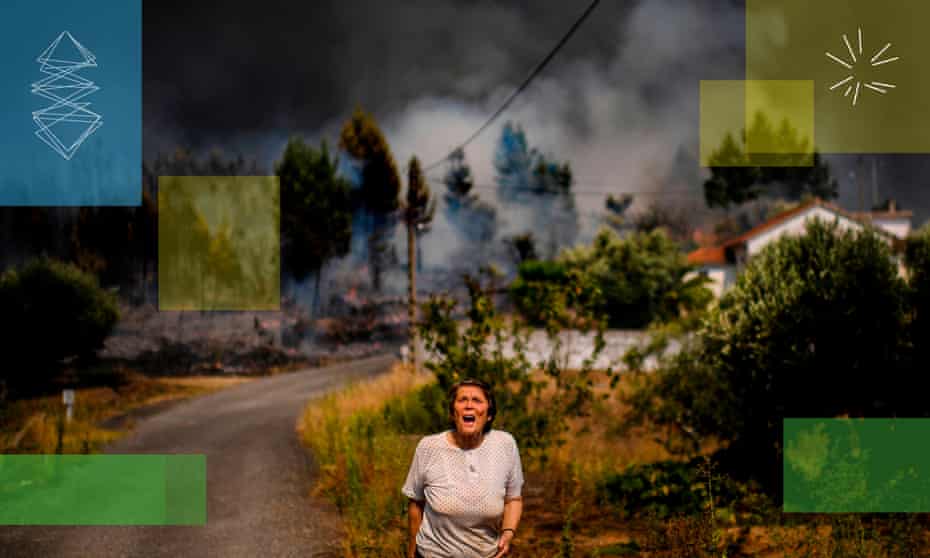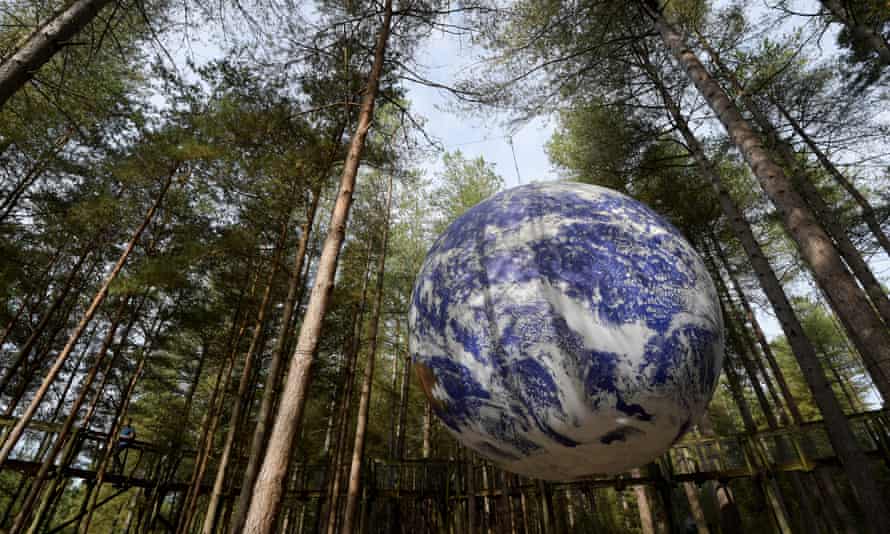Extract from The Guardian
From the business section to the food magazine, Guardian editors are becoming focused on one dominant story.

‘We need images that viscerally depict how the emergency is affecting lives around the world’: a woman calling for help as a wildfire approaches hoiuses in a Portuguese village, 2019.
Here, 10 Guardian journalists describe how the climate crisis is changing their job.
Business
The Guardian’s business team, including our transport and energy correspondents, devotes a significant part of its coverage to environment and the climate crisis. For companies, these are no longer optional considerations – they must embed them into their ways of working, and plan for significant changes in the years ahead.
In a similar way, the environment is at the heart of the stories we tell. We hold businesses to account on environmental pledges, ferreting out greenwashing, investigating conflicts of interest, exploring myriad subsidy schemes and interrogating the details. We tell the stories of lives and communities that are affected by the climate crisis as industries such as oil and gas and automotive manufacturing are upended.
We also explore the economic impact of these changes, how governments and policymakers can influence decisions, how the transition can be managed in a just way. John Collingridge, business editor
Culture
It’s hard to think of an aspect of modern life that has been untouched by the climate emergency, and the arts world is no exception.
Increasingly, artists are forcing us to confront the issue head-on, meaning that our culture writers often find themselves channelling the latest climate anxieties. Almost 10 years ago, Guardian critic Michael Billington called Stephen Emmott’s Ten Billion, which laid out the crisis in detail, “one of the most disturbing evenings I have ever spent in a theatre”. Oscar-winner Bong Joon-ho’s Snowpiercer imagined a world encased in ice after humanity failed to get to grips with global heating. Wolfgang Tillmans’s 2011 photograph Waste Power Station depicted a world drowning in rubbish, while Richard Powers’s celebrated book The Overstory inspired a wave of cli-fi – novels inspired by the climate crisis.
In terms of practical action, however, things are more scattershot. The Serpentine Gallery is currently running a project called Back to Earth, for which about 60 artists and scientists are collaborating on initiatives responding to the crisis. The Frieze art fair has switched to Green D+ biodiesel fuel for its generators. The Royal Court theatre in London banned single-use plastic bottles in a bid to go fully carbon neutral. The band Massive Attack commissioned their own report on how touring might become more sustainable. And the recent Inside Out festival in Dorset featured a group of performers inviting their audience to consider our relationship with the planet with the aid of soil-throwing dances and a giant globe suspended among the trees.
For years, the production of culture involved sending people and objects flying around the world. It ate up resources voraciously; even sent journalists to far-flung countries to meet artists for short interviews. We are now acutely aware of the waste involved. The pandemic has taught journalists that interviews can be done satisfactorily on Zoom, even if there is sometimes no substitute for seeing works and people in real life. We’re still figuring this conundrum out. Use local writers instead? Travel by train rather than by air? Be extremely sparing about foreign trips? All of these, plus other solutions we haven’t worked out yet, deserve consideration as we change in tandem with the world we’re covering. Alex Needham, culture editor
Technology
If you’re ordering books, searching for gig tickets or checking your friend’s birthday online, then you’re adding to the huge power consumption of major US tech companies. The combined power usage of Amazon, Apple, Microsoft, Google and Facebook is about as much as New Zealand’s.
According to the International Energy Agency, since 2010 the number of internet users worldwide has doubled while global internet traffic has grown 12-fold. That’s a lot of energy, a lot of carbon dioxide and a lot of plastic and metal for the accompanying computer, mobile-phone and network-infrastructure hardware. Datacentres and data transmission networks – all made ever busier by surging internet and mobile phone use – each account for about 1% of global electricity use. Mining of bitcoin alone accounts for as much as 0.3% of global electricity use.
The sustainable use of resources is an important strand of our technology coverage. Our product reviews incorporate a key sustainability ranking. Our scrutiny of Big Tech includes their environmental credentials, including promises to become carbon neutral. Microsoft, Apple and Amazon have all set major environmental targets for 2030. Given their size and their central role in our lives, it’s important that we keep a close eye on whether they are met. Dan Milmo, global technology editor

Luke Jerram’s installation Gaia on diplay at the Inside Out festival. Photograph: Finnbarr Webster/Getty Images
Photography and visual journalism
Two years ago, we published new thinking on our editorial use of pictures to portray the climate crisis. In short, it was out with cliches like polar bears and penguins, and in with images that viscerally depict how the emergency is affecting lives around the world. We no longer wanted the symbolic and abstract, we wanted real-life manifestations of the climate crisis.
Since then, the proliferation of extreme weather events has generated the kind of images that really bring home the size of the challenge we face: week after week we see images of devastating floods, wildfires, droughts – and the people caught in the middle of them. This human impact, we feel, is a much more dramatic way of projecting the urgency of the crisis.
My team sifts through about 30,000 new images every day. It’s striking to note how a growing proportion of them reflect the climate struggle from parts of the world that are really on the frontline. Photojournalists are much more alive to these stories, and are filing them under “climate crisis” rather than just under “flood” or “storm” as they used to.
When it comes to the summitry and the politics, as it inevitably does, the drama is often to be found in the surrounding demonstrations. Protest pictures used to be rather ordinary. Now, ever since Greta Thunberg really, they have become much more visual, with lots of young people involved, inventive placards that give you a different angle. That’s what we are looking for.
Additionally, at something like Cop26, there will be a lot of photo exhibitions and creative projects on display, so it’s a good showcase for some of the incredible work that photojournalists and artists have been doing. We’ll be keen to explore this imagery and assess what new elements it brings to the genre. Fiona Shields, head of photography
Fashion
Until a few years ago, sustainability was a discussion which happened on the fringes of fashion. It is now a vital lens through which we consider every aspect of the industry.
There is no bigger story in fashion than the environmental impact of mass-produced clothing. The days of writing only about hemlines and mood boards are over; holding the industry to account is at the core of our beat. So we look behind the scenes and find out where the fabric was sourced from, how long the supply chains are, and whether workers’ rights are being protected. We interrogate where the industry is falling short on its responsibilities – and shine a light on progress where it is being made. (Trainers made from vegan mushroom leather, anyone?)
We want to have a nice life, but we also want to live a good life. That is not just about fashion, but fashion is a good place to start.
So
when we showcase a new trend, we suggest options on how you could rent
the look or buy a vintage version. The sustainability metric which we
apply to everything we do follows clothes on their journey from workshop
and factory, to the gloss of shows and retail, to what you (really)
need in your wardrobe – and what happens to your clothes when you’re
bored with them. You’ll find fewer articles about wardrobe clearouts,
and more about mending and upcycling. Jess Cartner-Morley, fashion editor
Agriculture
Globally, agriculture is estimated to account for approximately one-third of greenhouse gas emissions. Food emissions in the US, with its huge levels of meat and dairy consumption, are the third highest in the world behind China and Indonesia, accounting for 8.2% of global food emissions.
A major Guardian US series called Our Unequal Earth examines the winners and losers of the country’s food system – and the climate crisis is at the centre of the series. We are looking at the ways the US food system has focused – in the words of the UN special rapporteur on the right to food – on “dominating nature instead of working with nature and enhancing biodiversity”.
A widely read story we published about networks of Indigenous women in the US and Central America reclaiming and celebrating ancient traditions gave us a glimpse of how much interest there is in food sovereignty and alternatives to industrialised food systems.
Those systems work very well for big corporations, like those in the US which make billions of dollars as market consolidation allows them to dictate terms to consumers. They do not work so well for small farmers, or migrant workers toiling in heatwaves or meat processing plants. And they do not work for the planet, given the true costs of industrialised agriculture, factory farms, and monocrops.
That is an unpalatable truth that we will continue to report on. Mark Oliver, US news editor
Food
Eating feels so complicated sometimes now, doesn’t it? So many tricky choices. But we know we have to change the way we eat – and in particular to eat less meat.
Our food teams are wary of telling people how to feed their families at a time when millions rely on food banks and face shortages, cuts to their income and rising prices.
But when it comes to recipes, we can help. There are about 23,000 on the Guardian website, including plenty of ideas for meat eaters, so we rarely add new beef ones. Our cooks flag when you could use meat with a lower environmental impact or how you might veganise it.
Thomasina Miers is The New Flexitarian, creating easy midweek dishes for people who want to cut down on meat but aren’t ready to give it up completely. For those who want to go further and be fully plant-based, Meera Sodha writes a delicious weekly vegan recipe.
Fish is tricky, as the documentary Seascape revealed. Some species are plentiful, some endangered. But it depends where and how they’re caught. And it changes by season and year. We aim to publish recipes for sustainable fish – in the UK, we follow the Marine Conservation Society’s Good Fish Guide, which has a traffic light system. We watch for green.
If this is all making you want a glass of wine, you might think about the environmental impact of that choice too.
We’ve been talking about food at the Guardian for 200 years. The first edition of the paper in 1821 carried an advert for a new vegetable cookery book and we reported on the heated words and cold sago pudding at the Vegetarian Society’s 1850 banquet. There’s more than ever to chew on. Tim Lusher, editor, Feast

Meera Sodha’s recipe for cavolo nero, fennel and chilli spelt risotto. Photograph: Louise Hagger/The Guardian
Global development
Ten years ago, climate was a side issue for development journalists. We were of course aware that unseasonal rains and drought had knock-on effects: people living with HIV would struggle with their medication, because ARTs were not to be taken on an empty stomach; girls would be pulled out of school to look after siblings while their mothers took longer journeys to collect water. But the links to climate were more often than not opaque.
But now, it’s rare to have a global development story that isn’t heavily coloured by the climate emergency in some way – from women’s rights to conflict.
So when we cover family planning issues in Uganda, there is a climate dimension: having fewer, healthier children will put less pressure on farmland and biodiversity. When we cover migration in Bangladesh, for example, it often stems directly from an unpredictable climate that makes land harder to work.
Even natural disasters like the swarms of locusts across parts of Africa, Asia and the Middle East, have a climate angle. Unseasonal rains created the moist conditions that desert locusts need to breed.
Fortunately, as the crisis deepens, we are also seeing more people trying to find solutions – from Palestinian entrepreneur Majd Mashharawi creating affordable, off-grid solar kits for families in Gaza, to Paul Matovu finding space-saving ways to farm in Uganda, and Nnaemeka Ikegwuonu creating mobile, solar-powered storage facilities to store food and prevent waste in Nigeria. Liz Ford, deputy editor, global development
Sport
Tennis players suffering from heatstroke at the Australian Open, a hurricane destroying Grenada’s national stadium, athletes struggling in the intense heat of Doha, a typhoon wiping out matches at the Rugby World Cup in Japan, air pollution in Delhi leaving Test cricketers vomiting on the pitch … the sporting world is not exempt from climate change, and has serious questions to answer.
Are those ever-changing team kits really sustainable? How much water is used to tend to grass pitches? Is it ethical for teams to fly round the world to play games? What about sponsorship by petrochemical companies as a way of sportswashing their reputations?
Athletes are starting to find their voices. Big names such as Olympian Katherine Grainger, Wallabies captain David Pocock, Australian cricketers Rachael Haynes and Pat Cummins, Héctor Bellerín of Arsenal, and Olympic gold-winning canoeist Etienne Stott (who has been visible at Extinction Rebellion protests) are working to make sport more sustainable and trying to inspire their fans. Our sports journalists are increasingly aware of this as they cover the story off the pitch as well as the one on it.
Research shows that sports stars now have the most influential voices on the planet – just look at what Marcus Rashford has been able to achieve. Sport doesn’t have a grand seat in the room at Cop26, but as a means of communicating the severity of the climate crisis and inspiring generations, it has a reach politicians can only dream of. Tanya Aldred, sports writer
Economics
Few parts of the economy are immune to the climate crisis. In the US, for example, the crisis looms over the threat to coastal properties from rising sea levels, droughts in agriculture, extreme heat’s impact on farming and construction work, and climate-related supply-chain disruptions from domestic and international suppliers.
The US remains the world’s most powerful and innovative economy and is likely to set the pace of change for the rest of the world. But many of the US’s most powerful corporations are lobbying to see off regulation that would force or speed up change in favour of “market-based solutions”, and in Washington political tensions can quickly undo the best-laid plans of even the most staunch supporters of change.
With its global perspective and focus on minorities and other underserved groups, the Guardian is ideally positioned to expose greenwashing, champion those communities most affected by climate change and hold business, and its overseers, accountable in what will be the defining struggle of our age. Dominic Rushe, US business editor
No comments:
Post a Comment